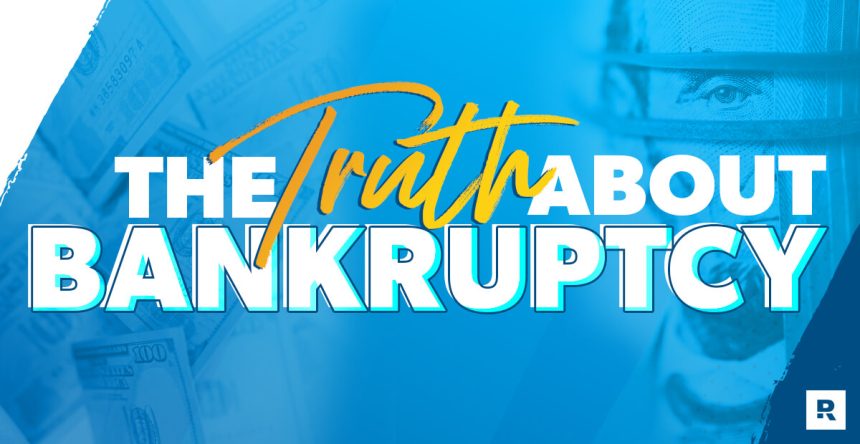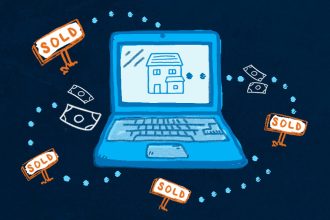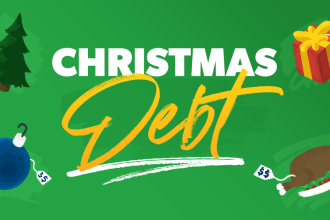If you’re reading this, you’re probably thinking about (or in the middle of) bankruptcy. The world may tell you this route is a fresh start . . . or a horrible ending. But what’s the truth about bankruptcy?
In simple terms, bankruptcy is a legal process you can go through if you’re buried under so much debt that you can’t pay it. After you declare bankruptcy, a court looks at your assets and what you owe, and then decides whether to cancel all or some of your debt.
But listen: If you’re so overwhelmed by debt that bankruptcy feels like your only option, know these three things: 1) There is hope—and you will be okay. 2) You have options and alternatives to bankruptcy—and you should try every single one before jumping into bankruptcy. 3) Bankruptcy does not define you and will not be the end.
Keep these three things in mind as you read through the rest of this article and learn the truth about bankruptcy, including a breakdown of these specific topics:
What Is Bankruptcy?
What Are the Types of Bankruptcy?
How Does Bankruptcy Work?
What Happens When You File for Bankruptcy?
What Are the Consequences of Declaring Bankruptcy?
Should You Declare Bankruptcy?
Bankruptcy Laws in Your State
5 Alternatives to Filing for Bankruptcy
What Is Bankruptcy?
Bankruptcy is a legal proceeding where you must prove to a court that you can’t pay your debt. A court trustee looks through your assets and liabilities (aka what you own and what you owe). If the court finds that you really have no means to pay back what you owe, it will discharge (or cancel) some or all of your debt. The court also might require you to sell your assets to pay some of your creditors (the people you owe money to) or set up a payment plan.
What Are the Types of Bankruptcy?
There are six different types of bankruptcy:
Chapter 13 Bankruptcy
Chapter 13 is a bankruptcy method for individuals where the court approves a plan for you to repay some or all of your debts over three to five years. You get to keep your assets, and you’re given time to bring your mortgage up to date. Then you agree to a monthly payment plan and have to follow a strict budget monitored by the court. (There’s no privacy in bankruptcy.)
People can file for Chapter 13 bankruptcy if their unsecured debt is less than $465,275 and their secured debt is less than $1,395,875.1 Unsecured debt is debt that’s not connected to collateral (something of value like a home or a car). Credit card debt is an example of unsecured debt. Home and car loans are secured debt because they’re connected to collateral that a lender can take (aka foreclose or repossess) if you stop making loan payments.
Unfortunately, though, most people who declare Chapter 13 bankruptcy end up not being able to make their payments—because they really haven’t changed their spending habits—and end up converting to Chapter 7 bankruptcy.
Chapter 7 Bankruptcy
Chapter 7 bankruptcy is the most common type of bankruptcy for individuals. In this case, the court sells all your assets (if you have any)—with some exceptions—so you can pay back as much debt as possible. The remaining unpaid debt is usually erased.
You could lose your home (or the equity you’ve put into it) and your car in the process, depending on what the court decides. There’s no set amount of debt you need to qualify for Chapter 7 bankruptcy—the court just has to decide you don’t make enough money to pay off your debt.
Chapter 11 Bankruptcy
Usually just for businesses, Chapter 11 bankruptcy creates a plan for how a business can still run while paying off all its debt.
Chapter 12 Bankruptcy
Chapter 12 bankruptcy allows farms and fisheries to get on a payment plan for their debts to avoid foreclosure on their property.
Chapter 15 Bankruptcy
Chapter 15 bankruptcy is for international bankruptcy cases.
Chapter 9 Bankruptcy
Chapter 9 bankruptcy is a repayment plan for towns, cities, schools and the like to pay back their debt. In 2013, Detroit, Michigan, became the biggest city in American history to file for bankruptcy.
How Does Bankruptcy Work?
Before we get into the details about how to file for bankruptcy, just hear us when we say that bankruptcy sucks. It’s a devastating, life-altering decision. After you’ve tried everything else to avoid bankruptcy, and then tried everything else again, it should be your last option.
Get help with your money questions. Talk to a Financial Coach today!
If you can avoid it, avoid it. (We’ll cover 5 Alternatives to Filing Bankruptcy later on.) But if you do everything possible to avoid bankruptcy and still come to that point, here’s a quick overview of how to file for bankruptcy and the paperwork you’ll need to get ready.
How to File for Bankruptcy
- Figure out which type of bankruptcy to file for.
- Gather and organize the necessary documents to show you can’t repay your debts.
- Take a credit counseling course.
- Fill out your bankruptcy paperwork.
- Make sure you have money for fees (for a bankruptcy attorney and filing).
- File your bankruptcy paperwork.
- Send all the necessary documents to your bankruptcy trustee (the person appointed by the court to handle your case).
- Meet with this trustee in a 341 hearing (also known as a meeting of creditors).
- Take a debtor education course.
- Finish the bankruptcy process. Some or all of your debt may be forgiven. Or you might have to sell your assets to pay your debt.
- Rebuild your life and know you can rise from this situation!
Yeah—it’s no fun having attorneys and trustees dig through every bit of private information you’ve ever had. Really, the only upside is they don’t ask for that awkward eighth grade yearbook photo.
What Documents Do You Need to File for Bankruptcy?
There’s a heck of a lot of paperwork and forms and documents involved in bankruptcy, but let’s talk about what you need to gather up at the start:
- Tax returns for the past two years (for Chapter 7) or four years (for Chapter 13)
- Income documents (such as pay stubs from the past six months, your past two W-2s, and proof of any extra income sources like rental properties or Social Security)
- Mortgage information (like an appraisal, mortgage payment statements, and maybe the deed of trust and proof of home insurance)
- Vehicle information (such as proof of your vehicle’s value, any car loan statements, and maybe a copy of your registration and proof of car insurance)
- Retirement information
- Bank account statements
- Identification (meaning your valid photo ID and proof of your Social Security number)
- Other documentation showing any other debts or expenses (like alimony or child support)
Phew, that’s a lot. Bankruptcy isn’t an easy out! Also, your particular state or court system may require even more. Get ready to do a lot of hunting and have a lot of patience here.
What Happens When You File for Bankruptcy?
If you declare bankruptcy, creditors have to stop any effort to collect money from you, at least temporarily. Most creditors can’t write, call or sue you after you’ve filed. But even if you declare bankruptcy, the courts can require you to pay back certain debts. Each bankruptcy case is unique, and only a court can decide the details of your own bankruptcy.
Let’s talk for a moment about what types of debt bankruptcy does and doesn’t cover:
What Does Bankruptcy Cover?
- Bankruptcy can stop foreclosure on your home or repossession of property.
- Bankruptcy can stop garnishment of your wages. (Garnishment is when the court orders part of your paycheck to be sent directly to your creditor—without you ever seeing the money.)
- Bankruptcy clears unsecured debt—like medical and credit card debt—but not all of your other debts.
What Doesn’t Bankruptcy Cover?
- Student loans
- Government debts like taxes, fines or penalties
- Child support and alimony
- Secured debts like your home mortgage or a car loan (you’ll either have to sell those assets to pay creditors or negotiate payments to keep them—bankruptcy isn’t a life hack to get a free car!)
- Expensive items purchased right before filing bankruptcy, like boats or jewelry
What Are the Consequences of Declaring Bankruptcy?
We won’t sugarcoat it: Bankruptcy takes a huge emotional toll on a person. It ranks up there with divorce, loss of a loved one, and business failure. Beyond the emotional impact, here are some other effects of declaring bankruptcy:
Your bankruptcy becomes public domain.
This means your name and other personal information will appear in court records for the public to access. That’s right. Potential employers, banks, clients and businesses can access the details of your bankruptcy, and that means they might not want to do business with you. Would you want to hire an employee or lend money to someone who has a history of not paying their bills? Probably not.
Filing bankruptcy is expensive.
Filing fees for Chapter 13 bankruptcy will cost around $313, plus attorney fees, which can be $3,000 or more. For a Chapter 7 bankruptcy, you’ll shell out $338 for filing fees and about $1,300 for an attorney.2 3
Buying a home can be more complicated after a bankruptcy.
Unless you pay cash for a home, it could take one to four years before you can qualify for a mortgage loan again.4
Bankruptcy affects your credit score.
We aren’t pro-credit scores, but it’s important for you to know a bankruptcy dings your FICO. Hard. And that ding lingers. Chapter 13 bankruptcies stay on your credit report for about seven years, and Chapter 7 stays on there for 10 years.
Bankruptcy doesn’t clear all debts.
We’ve touched on this some, but declaring bankruptcy doesn’t make all your problems go away—and it doesn’t even make all your debt go away. Most student loans, alimony, child support, reaffirmed debt (debt you negotiate with a creditor to repay), unpaid taxes, government debts, or court fines aren’t cleared in a bankruptcy.
Should You Declare Bankruptcy?
Listen. We’ve said it before, and we’ll say it again: Bankruptcy should be your very last option. Check out all the alternatives (aka how to avoid bankruptcy) below. Try each and every one. If nothing works and you’re still so overwhelmingly underwater that you simply can’t swim—then and only then do you declare bankruptcy.
Bankruptcy Laws in Your State
For specific information about bankruptcy laws in your area, visit the United States Courts website. You’ll find info on the process and where to find help near you. There’s a bankruptcy court for each judicial district in the United States—90 districts in all.
5 Alternatives to Filing for Bankruptcy
Before you even start gathering up that giant pile of documents you need to file for bankruptcy, go through this list of alternatives:
1. Get on a budget.
Budgeting may seem intimidating, but it’s just a plan for your money. And if you’re planning to get out of debt and avoid bankruptcy, you can’t do it without a budget. You need to see exactly what money you have coming in and where all of it’s going.
Once you see what your money is doing, you can start telling it what you want it to do. And what you want is to have more money freed up to pay off that debt.
That means cutting extras and spending less money. That means learning tips on how to save money on everything. That means being super intentional with every single dollar you make and spend.
Yes, it’s work. But it could be the exact thing that keeps you from bankruptcy. Don’t skip this.
2. Cover your Four Walls.
When you’re making a budget that will work for you right now, where do you start? What’s the most important stuff you need to focus on covering? Start with what we call your Four Walls: food, utilities, shelter and transportation. These are the essentials.
Keep everyone fed, the lights on, a roof over your heads, and gas in the car to get to work. If these Four Walls are the only things you can pay for while you’re getting out of debt, that’s called survival mode, and that may be what you need to jump into right now.
3. Sell everything you can.
Here’s the deal: If you declare bankruptcy, you’re probably going to lose some of your stuff anyway. So right now, sell everything you can. Be the one in charge of what goes and what happens to the money coming in from those sales. Put all of that money straight toward your debt.
4. Talk to a financial coach.
You don’t have to walk this alone. Read that again: You don’t have to walk this alone. Get with a financial coach and talk about your situation. They aren’t here to judge—they’re here to help.
A financial coach can help you figure out a personalized plan of action for your specific situation. And yes, talking about money can be terrifying, but if you declare bankruptcy, your financial privacy will fly out the window immediately. Opening up to a trustworthy financial coach now can help you avoid having to open up to a whole courtroom of people in bankruptcy.
Read the full article here














